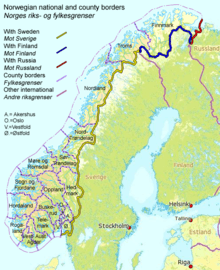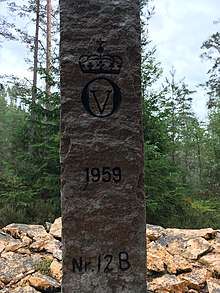Norway–Sweden border

The Norway–Sweden border (Norwegian: Svenskegrensa, Swedish: Norska gränsen) is a 1,630-kilometre (1,010 mi) long land national border,[1] and the longest border for both Norway and Sweden.
History
The border was changed several times because of war. Before 1645, Jämtland, Härjedalen, Idre/Särna parish, and Bohuslän belonged to Norway. The border changes were defined in the Treaty of Brömsebro (1645), the Treaty of Roskilde (1658) and the Treaty of Copenhagen (1660).
In 1751 a treaty was signed in Strömstad, defining the border based on field investigations and negotiations done 1738–1751. The border was based on knowledge among local people, mainly which farm belonged to which parish and which parish to which diocese. In the unpopulated mountains, the border mainly followed the water divide. There were disagreements on the parishes of Särna, Idre, Lierne, Kautokeino and Karasjok, which had to be solved by give-and-take. Based on that, in 1752–1765 border cairns were erected between Norway and Sweden including Finland, which mostly remain today.
After the Treaty of Kiel and the Convention of Moss (1814) the union between Sweden and Norway was established, and the Norway–Sweden border became a border between two union partners. In the Negotiations in Karlstad which led up to the dissolution of the union in 1905, Norway was obliged to tear down several fortresses along the border.
During World War II, when Norway was occupied by Germany and Sweden was neutral, many Norwegians became refugees and were transported or fled over the border. The regulation of Norwegian immigrants was strict between 1940 and 1941; several would-be-refugees were declined.[2]
Geography
In Dalarna and north of it, the border usually follows the drainage divide in the Scandinavian Mountains between rivers that flow to the Norwegian Sea or Skagerak and rivers flowing to the Baltic Sea. Exceptions to this are Rogen and Lierne which are not located on the same of the border as the drainage divide. South of Dalarna, the border in part follows local drainage divides, but also across lakes and along rivers. Some border marks were placed on small lake islands so that they got divided by the border.
In Norway, the border lies along the counties, from south to north, of Østfold, Akershus, Hedmark, Sør-Trøndelag, Nord-Trøndelag, Nordland and Troms. In Sweden, the border lies along the counties, from south to north, of Västra Götaland, Värmland, Dalarna, Jämtland, Västerbotten and Norrbotten. The northernmost border point is Treriksröset (Swedish) or Treriksrøysa (Norwegian), which is also a border to Finland.
There is a clear-cut zone (border vista) along the border where there are forests.
Control
Both countries are members of the Schengen Area, and there are therefore no immigration controls. However, only Sweden is part of the European Union (and crucially the European Union Customs Union) and there are customs checks between the two countries. These checks are performed by the Norwegian Customs and Excise Authorities and the Swedish Customs Service.[3] These checks are sporadic along the Norway–Sweden border. Cars are usually not forced to stop. To combat drug smuggling, the use of CCTV surveillance has recently been increased, with systems using Automatic number plate recognition being rolled-out in 2016 and 2017.[4]
Both Norway and Sweden emphasise checks against other countries. For flights and ferries between the two countries, there are no formal passport checks at airport and ferry ports, but identity cards are needed to board.
Before 2001, the countries were not part of the Schengen Area, but even then there was no passport check, as both were part of the Nordic Passport Union, which was subsumed into the Schengen Area. Passengers were led to the passport control at international airports, but could pass simply by showing the ticket and/or speaking and looking Scandinavian. There were more road customs stations then, some have been closed for cost reasons.
Road border crossings
There are customs control stations at the following places (from north to south):[5]
| Place | Customs station | Road S | Road N | |||||
|---|---|---|---|---|---|---|---|---|
| Björnfjell | N | E10 | ||||||
| Junkerdal | N | 95 | 77 | |||||
| Tärnaby | S | E12 | ||||||
| Storlien | S | E14 | ||||||
| Vauldalen | N | 84 | 31 | |||||
| Østby | N | 66 | 25 | |||||
| Åsnes | N | 206 | ||||||
| Eda | S | 61 | 2 | |||||
| Ørje/Hån | N+S | E18 | ||||||
| Svinesund | N+S | E6 | ||||||
| N=Norway, S=Sweden, N+S in both countries | ||||||||
For most border crossings there is one customs station on one side of the border, but for some on both sides, one for each direction. A treaty gives the customs officers of one country the right to carry out clearance and checks for both countries.
There are around 30 more roads crossing the border, without customs station (most notably E16), but they are not allowed to use if having goods needing declaration. Heavy trucks can be allowed to use them by pre-declaration. They are surveilled by video and temporary checks.
Railway border crossings
There are four railway crossings. All four serve both passenger and freight trains. All border stations except Kornsjø Station are located in Sweden.[6]
| Border station | Norwegian line | Swedish line |
|---|---|---|
| Riksgränsen | Ofoten Line | Iron Ore Line |
| Storlien | Meråker Line | Central Line |
| Charlottenberg | Kongsvinger Line | Värmland Line |
| Kornsjø | Østfold Line | Norway/Vänern Line |
Norway has right hand traffic and Sweden has left hand traffic on double track railways. All four crossings are single track so the difference is no problem.
Riksrøysa/Riksrösen


Stone cairns, known as the Norwegian: Riksrøysa and Swedish: Riksrösen, mark many parts of the border.
Biological exchange
Animals, notably wolves and brown bear, have been known to wander across the border. Reflecting the fact that the population is shared, a Norwegian–Swedish research project named Skandulv was founded in 2000, and is administered by the Norwegian Institute for Nature Research, Hedmark University College and the Swedish University of Agricultural Sciences.[7][8]
See also
| Wikimedia Commons has media related to Norway-Sweden border. |
References
- ↑ "Oversikt over geografiske forhold". Statistics Norway. Retrieved 1 November 2010.
- ↑ Grimnes, Ole Kristian (1995). "Sverige, Norges forhold til". In Dahl, Hans Fredrik. Norsk krigsleksikon 1940-45. Oslo: Cappelen. Archived from the original on 24 July 2011. Retrieved 3 November 2010.
- ↑ "Travelling to Norway". Norwegian Customs and Excise Authorities. Archived from the original on 16 November 2010. Retrieved 1 November 2010.
- ↑ Can CCTV curb drug runs between Sweden and Norway? - The Local 24/10-2016
- ↑ Alphabetical list of customs offices Archived 2014-07-24 at the Wayback Machine.
- ↑ "Banestrekninger". Norwegian National Rail Administration. Retrieved 1 November 2010.
- ↑ "Hva er SKANDULV?" (in Norwegian). Skandulv. Archived from the original on 24 July 2011. Retrieved 3 November 2010.
- ↑ "Deltakende institusjoner" (in Norwegian). Skandulv. Archived from the original on 24 July 2011. Retrieved 3 November 2010.